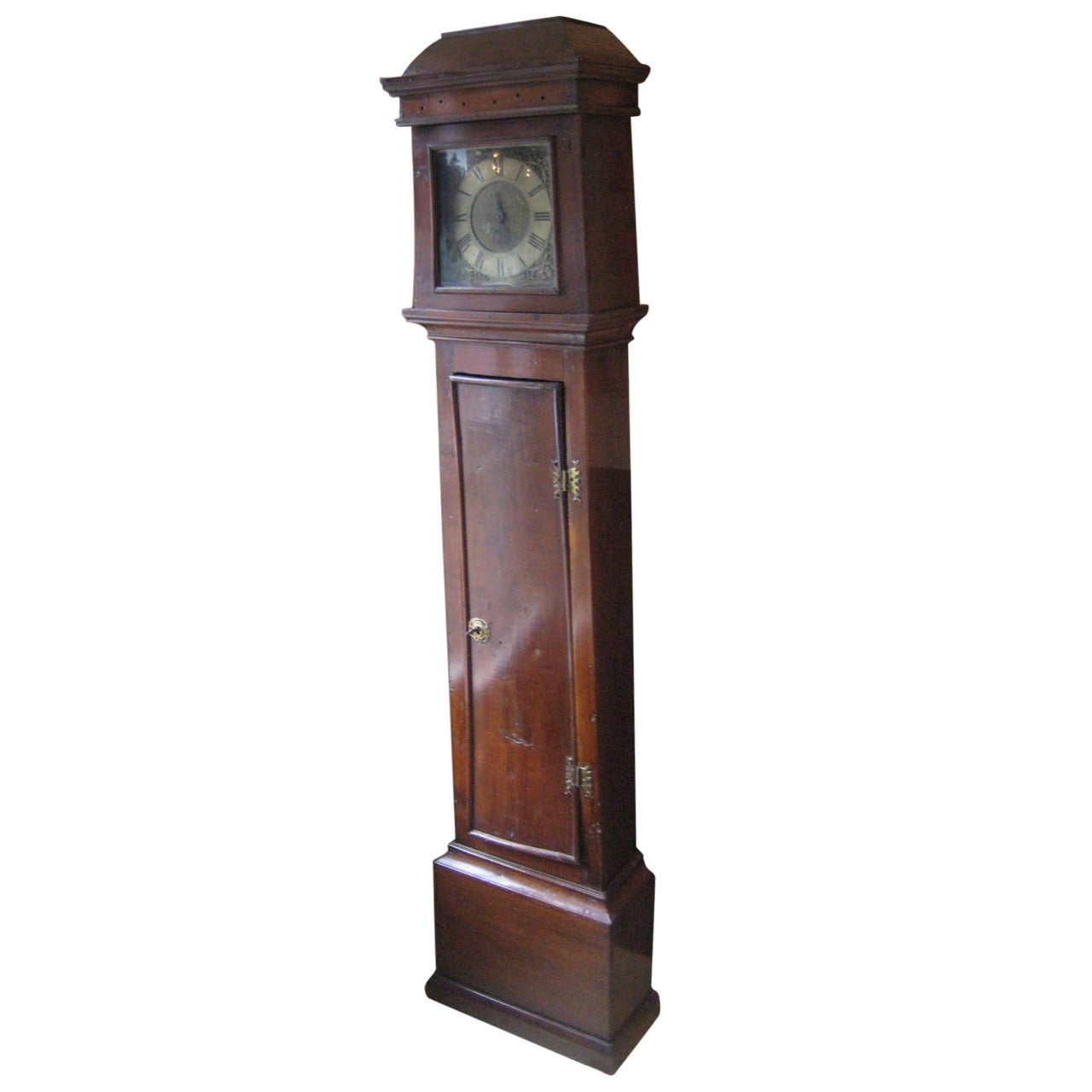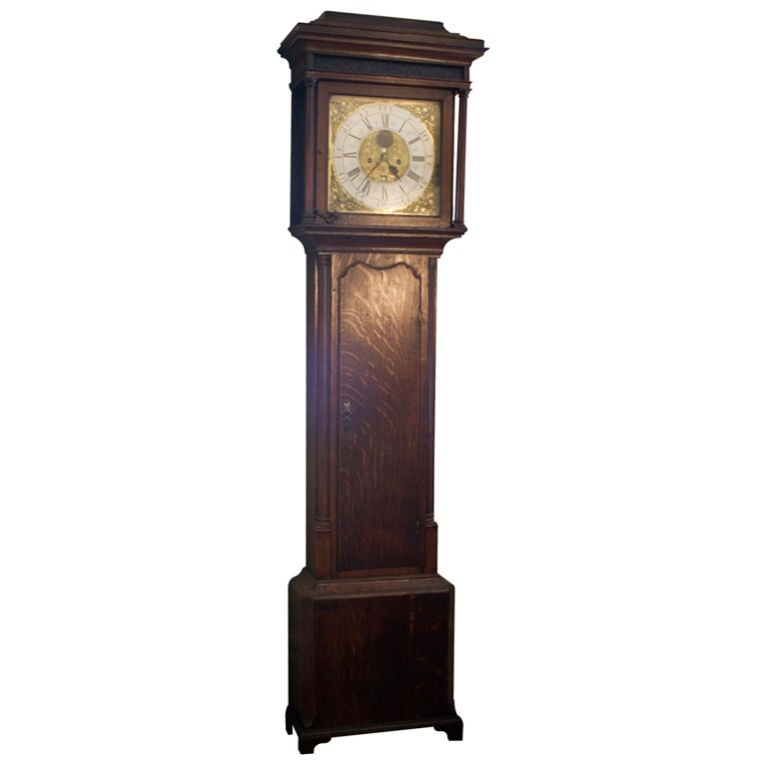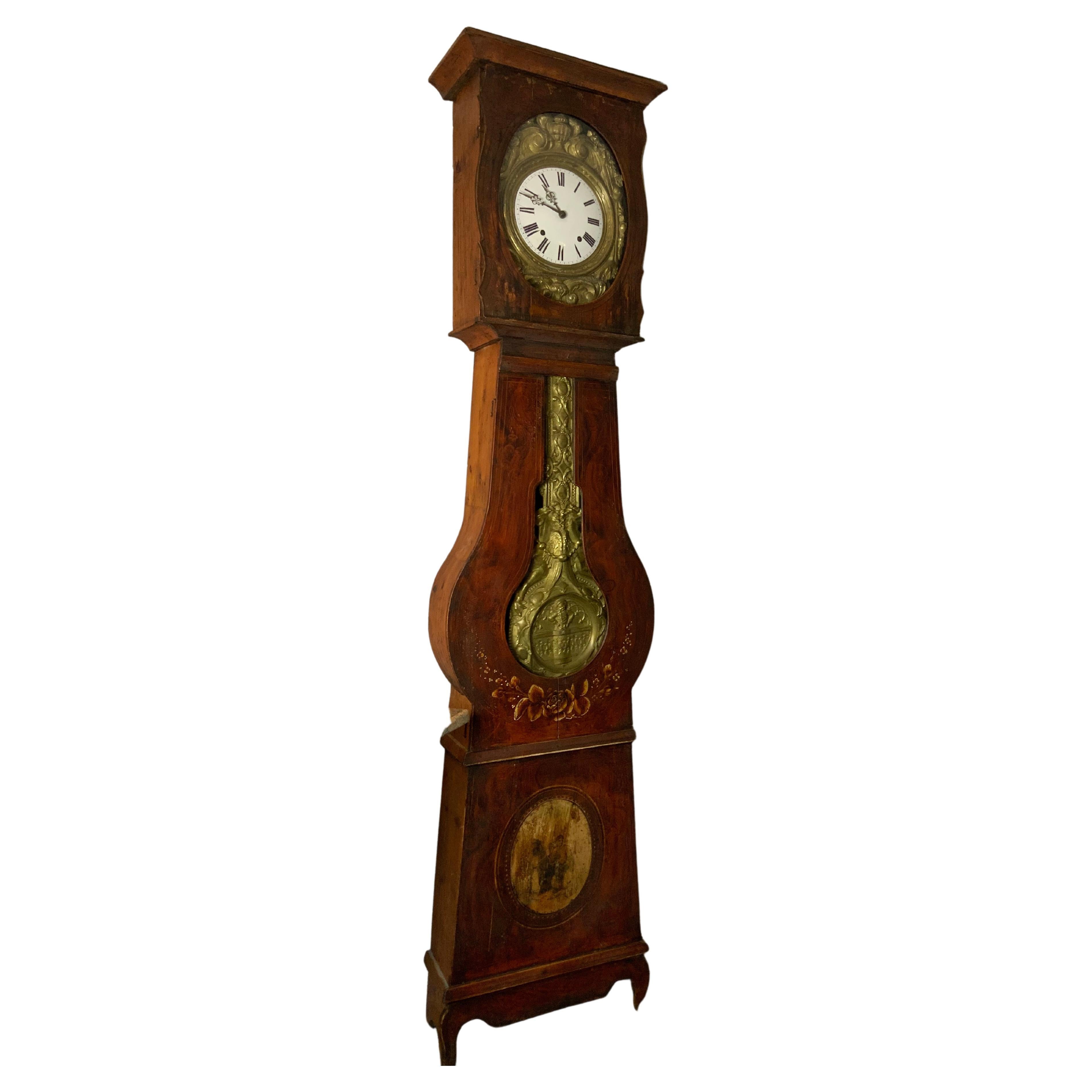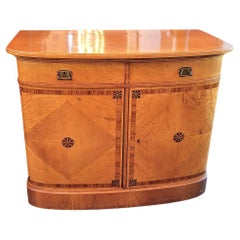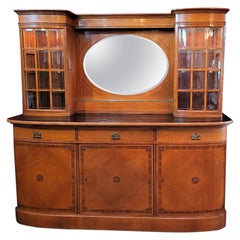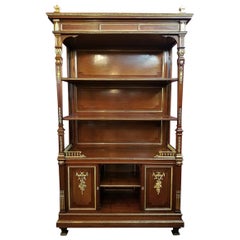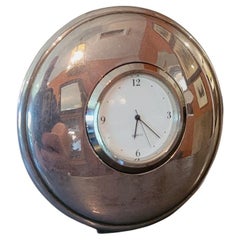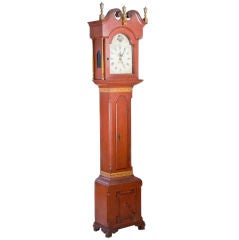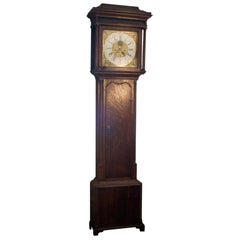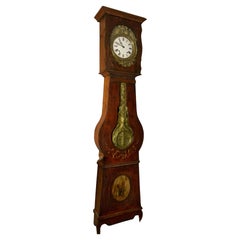Items Similar to Art Deco Portois and Fix Viennese Tall Case Clock
Want more images or videos?
Request additional images or videos from the seller
1 of 21
Art Deco Portois and Fix Viennese Tall Case Clock
About the Item
Presenting an amazingly rare piece of Art Deco furniture by an exceptionally rare maker, namely, an Art Deco Portois and Fix Viennese Tall Case Clock.
Part of a complete Dining Room Set comprising of 3 pieces – this Clock, Buffet/Sideboard and Credenza. All in our Inventory but being sold separately (or together if you have a desire to own the complete set which you will NEVER be in a position to do again).
Made in Vienna, Austria circa 1920-30 by the famous furniture maker of Portois & Fix.
The piece consists of a Tall Case Clock with glass display front.
The top section consists of a molded square pelmet with circular glass face door edged and banded with an inlaid border of parquetry inlaid woods. The door opens to the original porcelain clock/dial face with 2 original holes for winding. Hour and minute hands.
The original movement was removed in the 1950’s and replaced with an electric motor mechanism. This has now been replaced with a working battery operated quartz movement.
The pendulum and weights are the originals but are now only decorative in nature.
The main body of the clock is made up of a door with 8 beveled glass panels allowing views of the pendulum and weights.
The base section is likewise, edged and banded with an inlaid border of parquetry inlaid woods and a central parquetry medallion of inlaid woods.
Placed in connection with the other pieces in this Set, means we can say with certainty that this is an Art Nouveau moving into Art Deco piece, even though the design and style is more similar to Regency.
A stunning, important and exceptionally rare & desirable piece
Condition: The case of the piece is in very good original condition. The porcelain dial face has a small crack but the original movement has been completely removed in the 1950’s and was originally replaced with an electric motor mechanism (see photos). This has now been replaced with a fully functional quartz battery operated movement. The pendulum and weights are the originals but purely now serve as decorative only.
Specific provenance:
This piece was purchased and imported by Olga Mangold in the very early 1930’s to Dallas, TX directly from Portois & Fix. The piece was imported through the Port of New Orleans as is marked on the back of the piece. The back also have the Portois & Fix stamps and marks.
Olga Mangold was the daughter of well known early Dallas real estate developer Carl A. Mangold, who is an important figure in Dallas History and credited with really developing the Oak Cliff suburb directly south of downtown.
Olga lived in a mansion in the University Park Area of Dallas and these pieces held pride of place in her dining room. We have Olga’s Scrapbook which has been passed down through the generations of descendants and you will see the photos of the set in her home with her typed entry in her scrapbook about the pieces, as she was obviously very proud of them.
Later in life, around 1950, Olga moved to Colorado Springs and brought the pieces with her. She obviously had a restorer work on the pieces whilst in Colorado Springs and this explains the lighting on the buffet and the work on the tall case clock (dealt with separately under the posting of the clock). The restorer was a Mr. Vandenberg as wriiten on the back.
After her death in 1988, the family brought the pieces back to Dallas where they have remained in family ownership since.
Charles A. Mangold Sr., the father of Carl Mangold, was one of the pioneers of Dallas County. successful sucsessful as a businessman, builder and manager of the Jefferson Hotel, and a horse breeder, Mangold was also a leader and developer for public interest. He was involved in a variety of activities promoting the arts, such as the Opera, Oak Cliff Little Theatre, and the Silver Jubilee Saengerfest (1904). He organized Lake Cliff Park and helped with the Dallas State Fair. His name appears on many city promotions including the early founders of the Chamber of Commerce and membership rosters of many fraternal organizations such as Odd Fellows, the Elks, the Eagles, and the Sons of Herman. Charles Mangold was one of the leaders in developing Dallas from a small village to a major city.
Charles Mangold was born October 31, 1860 in Cincinnati, Ohio. He arrived in Dallas in 1885 and established a wholesale liquor enterprise known as Swope and Mangold. Almost immediately upon his arrival in Dallas, Mangold became interested in the development of Dallas and Oak Cliff. He was responsible for the crusade to build a viaduct between the two cities in 1910. His interest also extended to the creation of city parks and was one of the original members of the parks board.
His many commercial enterprises included breeding Angora goats and horses, plus the running of horse races at the fair grounds, the Oak Cliff Casino, wholesale liquor, wines and cigars, the Jefferson Hotel, and the American Laundry Company. He endeavored to make all of his works unique, successful, and first rate. His contributions to Dallas County are well noted in several sources. After his death, August 26, 1934, his obituary appears in the Dallas Morning News, August 27, 1934, front page and proclaims him as the “Man Who Visioned Oak Cliff”.
Chalres and wife Anna Mangold had four children, two daughters, Olga and Irma, and two sons, Lawrence W. and Charles A. Mangold Jr. (Carl). Both sons served in World War I. The younger son, Carl, entered the service in October 1918 and was discharged after the Armistice in November. Lawrence remained in the service and as a Sergeant Major was sent to Germany with the Army of Occupation. Carl followed his father’s lead and became a developer, helping his father with Cliff Towers, Lake Cliff Park, and the Jefferson Hotel. Carl donated this collection to this library after an oral history interview. Carl A. Mangold died in February 1987 at age 87.
- Creator:Portois & Fix (Maker)
- Dimensions:Height: 83 in (210.82 cm)Width: 18.75 in (47.63 cm)Depth: 11.4 in (28.96 cm)
- Style:Art Deco (Of the Period)
- Materials and Techniques:
- Place of Origin:
- Period:
- Date of Manufacture:1920-1930
- Condition:Additions or alterations made to the original: See full posting. Wear consistent with age and use. See full posting.
- Seller Location:Dallas, TX
- Reference Number:1stDibs: LU3978125407932
About the Seller
4.9
Platinum Seller
Premium sellers with a 4.7+ rating and 24-hour response times
Established in 2015
1stDibs seller since 2018
387 sales on 1stDibs
Typical response time: 1 hour
- ShippingRetrieving quote...Shipping from: Dallas, TX
- Return Policy
Authenticity Guarantee
In the unlikely event there’s an issue with an item’s authenticity, contact us within 1 year for a full refund. DetailsMoney-Back Guarantee
If your item is not as described, is damaged in transit, or does not arrive, contact us within 7 days for a full refund. Details24-Hour Cancellation
You have a 24-hour grace period in which to reconsider your purchase, with no questions asked.Vetted Professional Sellers
Our world-class sellers must adhere to strict standards for service and quality, maintaining the integrity of our listings.Price-Match Guarantee
If you find that a seller listed the same item for a lower price elsewhere, we’ll match it.Trusted Global Delivery
Our best-in-class carrier network provides specialized shipping options worldwide, including custom delivery.More From This Seller
View AllArt Deco Portois and Fix Viennese Credenza
By Portois & Fix
Located in Dallas, TX
Presenting an amazingly rare piece of Art Deco furniture by an exceptionally rare maker, namely, an Art Deco Portois and Fix Viennese Credenza .
Par...
Category
Early 20th Century Austrian Art Deco Credenzas
Materials
Brass
Art Deco Portois and Fix Viennese Buffet Sideboard
By Portois & Fix
Located in Dallas, TX
Presenting an amazingly rare piece of Art Deco furniture by an exceptionally rare maker, namely, an Art Deco Portois and Fix Viennese buffet sideboard.
Part of a complete Dining Room Set comprising of 3 pieces – this Buffet/Sideboard, Tall Case Clock ands Credenza. All in our Inventory but being sold separately (or together if you have a desire to own the complete set which you will NEVER be in a position to do again).
Made in Vienna, Austria circa 1920-30 by the famous furniture maker of Portois & Fix.
The piece consists of a Buffet or Sideboard with glass display pillars...
Category
Early 20th Century Austrian Art Deco Sideboards
Materials
Brass
Rare 19C Portois & Fix Viennese Cabinet
By Portois & Fix
Located in Dallas, TX
PRESENTING A STUNNING and RARE 19C Portois & Fix Viennese Cabinet.
Made by the famous and highly desirable maker, ‘Portois & Fix’ in Vienna, Austria ...
Category
Antique Late 19th Century Austrian Belle Époque Cabinets
Materials
Ormolu, Brass
$20,800 Sale Price
46% Off
Art Deco Style Chrome or Silveroid Desk Timepiece
Located in Dallas, TX
Presenting a lovely Art Deco style chrome or silveroid desk timepiece.
Probably made circa 1980.
The case is a solid circular shaped chrome or sil...
Category
20th Century American Art Deco More Clocks
Materials
Silver Plate, Chrome
19C Gustav Becker Vienna Wall Clock
Located in Dallas, TX
PRESENTING A GORGEOUS 19C Gustav Becker Vienna Wall Clock.
Made by the famous clockmaker, Gustav Becker circa 1880 in Germany.
Th...
Category
Antique Late 19th Century German Victorian Wall Clocks
Materials
Brass
French 19C Japy Freres & Red Sevres Porcelain Mantle Clock with Garniture Set
By Manufacture Nationale de Sèvres, Phillipe Mourey, Japy Frères
Located in Dallas, TX
PRESENTING A STUNNING mid to late 19C French Japy Freres & Red/Magenta Sevres Porcelain Mantle Clock with Garniture Candlestick Ewers.
The clock movement is by the famous Parisienne Clockmaker … ‘Japy Freres’ and the clock dial has the marks for “JAY” (short for Japy Freres) & “Paris” on the dial face.
The clock mechanism and clock face/dial have matching serial numbers of “7225”. The movement also has the numbers: “5 – 2”.
The clock face/dial also has the initials: “D.H.”.
The gilt ormolu clock case is gilt spelter and is signed on the rear base, for having been made by “P.H. Mourey” of Paris, who worked with and for ‘Japy Freres’, towards the end of the 19th Century.
The signature of ‘Mourey’ also bears the numbers “85” … probably for 1885, but could also be the serial number.
Taking into account Mourey’s historical association with Japy, being late 19th Century, we are leaning heavily towards this being the date of manufacture i.e. 1885.
The Clock has RARE red/magenta Sevres hand-painted porcelain paintings/additions, to include:-
(i) a 2 handled and lidded urn on the crown with pointed flame finial,
(ii) a pair of bulbous urns either side of the main body and clock face,
(iii) the clock face and dial itself and
(iv) a flat rectangular medallion on the front base.
The crown urn and the base medallion both have similar themes, but different painted scenes, depicting French rural countryside scenes with cottages, rivers and bridges.
The porcelain urns on the sides, likewise have hand-painted images of a young boy, in rustic period attire on the right and a young girl on the left.
None of these paintings appear to be signed.
The clock case has GLORIOUS detail to it, with scrolls, ribbons, vines, grapes and Corinthian columns.
The clock sits on a custom made gilt wood and burgundy velvet plinth, that is original to the piece and was a common accent with ‘Japy Freres Clocks’, when originally retailed in their Paris shop.
The rear of the clock is plain and the perspex/clear resin plate insert, is a new addition, but a nice addition, in that it allows one, to view the movement and pendulum works.
The clock is an 8 day movement with a strike on the hour and half hour. The clock face has 2 winding holes … one for the pendulum movement and the other for the striking chime/ring.
Unlike British clocks this clock does not have a long musical chime … it is a simple ‘single strike’ on the half hour.
The red/magenta Sevres porcelain clock face/dial is in SUPERB condition. Roman numerals with gilt accents and a hand-painted circular wreath/bouquet of spring flowers on the center section.
To complete the set, we have a matching pair of gilt ormolu spelter and hand-painted red/magenta Sevres porcelain Ewers … which can hold a single candle each.
The porcelain urns on the central section, have hand-painted images of a young lady in rustic period attire … fishing on the riverbank on the right and a young man playing the flute in the countryside on the left.
The front base medallions on each ewer have hand-painted wreaths/bouquets of spring flowers.
The clock facing side of the porcelain urn on each Ewer, has a brass ormolu applique head, of the Greek god of wine-making, orchards and fruit, vegetation, fertility, festivity, insanity, ritual madness, religious ecstasy, and theatre, namely, Dionysus.
The plinths are signed on the rear top left corner, and we think they read: “R.P. Unfaut”. They also bear the numbers “61” and “69”, Again, possibly for 1861 and 1869, but here we think it is more likely they are serial numbers, as it is highly unlikely that a matching pair were made 8 years apart!
Whilst we cannot find any information on ‘R.P. Unfaut’, we can only guess that he/she/they worked with, or for, ‘Japy Freres’, as these ewers are unmistakably, a ‘superb’ match for the clock!
The style, subject matter, gold banding and edging, around the paintings, are virtually ‘identical’ to the same decorations on the clock’s porcelain paintings.
The Ewer on the left (with the boy playing the flute) appears to have a faded signature on the gold border of the painting towards the base and we think it is the signature of ‘Alexandre Evariste Fragonard’ …. one of the best known artists attached to Sevres in the mid 19th Century … meaning, that these Ewers were probably made circa 1845-50.
The quality and detail to these 2 paintings is classic Fragonard!
We are of the opinion, therefore that these garnitures, were made circa 35/40 years before the clock, as Mourey was prevalent with Japy around 1880 – 1900.
The clock paintings are of a very similar, rustic ‘Fragonard Style’ subject matter and although unsigned, could possibly have been painted by a Sevres artist, to replicate the Fragonard paintings...
Category
Antique 19th Century French Rococo Revival Mantel Clocks
Materials
Ormolu
You May Also Like
Tall Case Clock
Located in Nantucket, MA
English yew wood tall case clock with narrow proportions.
Category
Antique Early 19th Century British Clocks
$13,500
Painted Tall-Case Clock
Located in West Chester, PA
Clock with broken-scroll pediment, three urn finials, enameled dial, fluted quarter-columns at the waist and base that has a wonderfully applied molding sur...
Category
Antique Early 19th Century Clocks
$29,500
English Tall Case Clock
Located in Nantucket, MA
English Sun/Moon Oak Tall Case Clock with brass face
Category
Antique 18th Century and Earlier English Clocks
Materials
Metal
$12,500
Comtoise Morbier Tall Case Clock
Located in Bradenton, FL
A very nice Comtoise Morbier tall clock in a floral paint decorated Pine case, France - late 19th century. Rings on the hour and two minutes after the hour...
Category
Antique 1870s French French Provincial Grandfather Clocks and Longcase C...
Materials
Pine
English Oak Tall Case Clock
Located in Woodbury, CT
Fancy for a country clock, this particular tall case clock has an impressive dial and mahogany crossbanding and inlay that dress it up in formal wear suitable for a country estate. A beautifully arched swan neck pediment on the bonnet leads the eye down to a painted break arch featuring the small portrait of a girl holding a dove. The narrow case...
Category
Antique 19th Century British Georgian Clocks
Materials
Oak, Mahogany
$13,150
Welsh Oak Tall Case Clock
Located in Woodbury, CT
This tall case clock has a beautifully painted enamel face with a pair of turtle doves featured prominently at the center, indicating that this clock was probably a wedding or annive...
Category
Antique 19th Century British Georgian Clocks
Materials
Oak, Mahogany
$10,850
